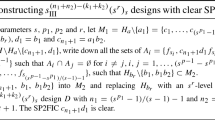Abstract
Fractional factorial (FF) designs are commonly used for factorial experiments in many fields. When some prior knowledge has shown that some factors are more likely to be significant than others, Li, et al. (2015) proposed a new pattern, called the individual word length pattern (IWLP), which, defined on a column of the design matrix, measures the aliasing of the effect assigned to this column and effects involving other factors. In this paper, the authors first investigate the relationships between the IWLP and other popular criteria for regular FF designs. As we know, fractional factorial split-plot (FFSP) designs are important both in theory and practice. So another contribution of this paper is extending the IWLP criterion from FF designs to FFSP designs. The authors propose the IWLP of a factor from the whole-plot (WP), or sub-plot (SP), denoted by the IwWLP and IsWLP respectively, in the FFSP design. The authors further propose combined word length patterns CwWLP and CsWLP, in order to select good designs for different cases. The new criteria CwWLP and CsWLP apply to the situations that the potential important factors are in WP or SP, respectively. Some examples are presented to illustrate the selected designs based on the criteria established here.
Similar content being viewed by others
References
Box G E P and Hunter J S, The 2k−p fractional factorial designs, Technometrics, 1961, 3: 311–351.
Fries A and Hunter W G, Minimum aberration 2k−p designs, Technometrics, 1980, 22: 601–608.
Wu C F J and Chen Y, A graph-aided method for planning two-level experiments when certain interactions are important, Technometrics, 1992, 34: 162–175.
Zhang R C, Li P F, Zhao S L, et al., A general minimum lower order confounding criterion for two-level regular design, Statistica Sinica, 2008, 18: 1689–1705.
Wu C F J and Hamada M, Experiments: Planning, Analysis, and Optimization, 3rd Edition, Wiley, New York, 2021.
Li W, Zhou Q, and Zhang R C, Effective designs based on individual word length patterns, Journal of Statistical Planning and Inference, 2015, 163: 43–47.
Bingham D and Sitter R R, Minimum-aberration two-level fractional factorial split-plot designs, Technometrics, 1999, 41: 62–70.
Bingham D and Sitter R R, Some theoretical results for fractional split-plot designs, The Annals of Statistics, 1999, 27: 1240–1255.
Mukerjee R and Fang K T, Fractional factorial split-plot designs with minimum aberration and maximum estimation capacity, Statistica Sinica, 2002, 12: 885–903.
Ai M Y and Zhang R C, Multistratum fractional factorial split-plot designs with minimum aberration and maximum estimation capacity, Statistics & Probability Letters, 2004, 69: 161–170.
Ai M Y and He S Y, Theory of optimal blocking for fractional factorial split-plot designs, Science in China: Series A Mathematics, 2005, 48: 649–656.
Cheng C S and Tsai P W, Optimal two-level regular fractional factorial block and split-plot designs, Biometrika, 2009, 96: 83–93.
Yang J F, Li P F, Liu M Q, et al., \({2^{({n_1} + {n_2}) - ({k_1} + {k_2})}}\) fractional factorial split-plot designs containing clear effects, Journal of Statistical Planning and Inference, 2006, 136: 4450–4458.
Zi X M, Zhang R C, and Liu M Q, Bounds on the maximum numbers of clear two-factor interactions for \({2^{({n_1} + {n_2}) - ({k_1} + {k_2})}}\) fractional factorial split-plot designs, Science in China: Series A Mathematics, 2006, 49: 1816–1829.
Zhao Q Q and Zhao S L, Mixed-level designs with resolution III or IV containing clear two-factor interaction components, Metrika, 2015, 78: 953–965.
Ai M Y and Zhang R C, Minimum secondary aberration fractional factorial split-plot designs in terms of consulting designs, Science in China: Series A Mathematics, 2006, 49: 494–512.
Zhao S L and Chen X F, Mixed two- and four-level fractional factorial split-plot designs with clear effects, Journal of Statistical Planning and Inference, 2012, 142: 1789–1793.
Zi X M, Zhang R C, and Liu M Q, On optimal two-level nonregular factorial split-plot designs, Journal of Complexity, 2012, 28: 459–467.
Han X X, Liu M Q, Yang, J F, et al., Mixed 2- and 2r-level fractional factorial split-plot designs with clear effects, Journal of Statistical Planning and Inference, 2020, 204: 206–216.
Han X X, Chen J B, Liu M Q, et al., Asymmetrical split-plot designs with clear effects, Metrika, 2020, 83: 779–798.
Bingham D, Multistratum fractional factorial designs, Handbook of Design and Analysis of Experiments (Eds. by Dean A, Morris M, Stufken J, et al.), CRC Press, Boca Raton, 2015, 321–338.
Sartono B, Goos P, and Schoen E D, Constructing general orthogonal fractional factorial split-plot designs, Technometrics, 2015, 57: 488–502.
Wei J L, Yang J F, Li P, et al., Split-plot designs with general minimum lower-order confounding, Science China Mathematics, 2010, 53: 939–952.
Huang P, Chen D, and Voelkel J, Minimum aberration two-level split-plot designs, Technometrics, 1998, 40: 314–326.
Bisgaard S, The design and analysis of 2k−p × 2q−r split-plot experiments, Journal of Quality Technology, 2000, 32: 39–56.
Li W, Mee R W, and Zhou Q, Utilizing individual factor information in fractional factorial designs, Technometrics, 2019, 61: 38–49.
Zhang R C and Mukerjee R, Characterization of general minimum lower order confounding via complementary sets, Statistica Sinica, 2009, 19: 363–375.
Huang P, Chen D, and Voelkel J, Minimum aberration two-level split-plot designs, Technometrics, 1998, 40: 314–326.
Author information
Authors and Affiliations
Corresponding author
Ethics declarations
The authors declare no conflict of interest.
Additional information
This research was supported by the National Natural Science Foundation of China under Grant Nos. 11811033, 11971204, 12101357, 12131001 and 12271270, National Ten Thousand Talents Program of China, Natural Science Foundation of Tianjin under Grant No. 20JCYBJC01050, Natural Science Foundation of Shandong under Grant No. ZR2021QA080, and the 111 Project B20016. The first three authors contributed equally to this work.
Rights and permissions
About this article
Cite this article
Han, X., Chen, J., Yang, J. et al. Individual Word Length Patterns for Fractional Factorial (Split-Plot) Designs. J Syst Sci Complex 36, 2082–2099 (2023). https://doi.org/10.1007/s11424-023-2023-1
Received:
Revised:
Published:
Issue Date:
DOI: https://doi.org/10.1007/s11424-023-2023-1




